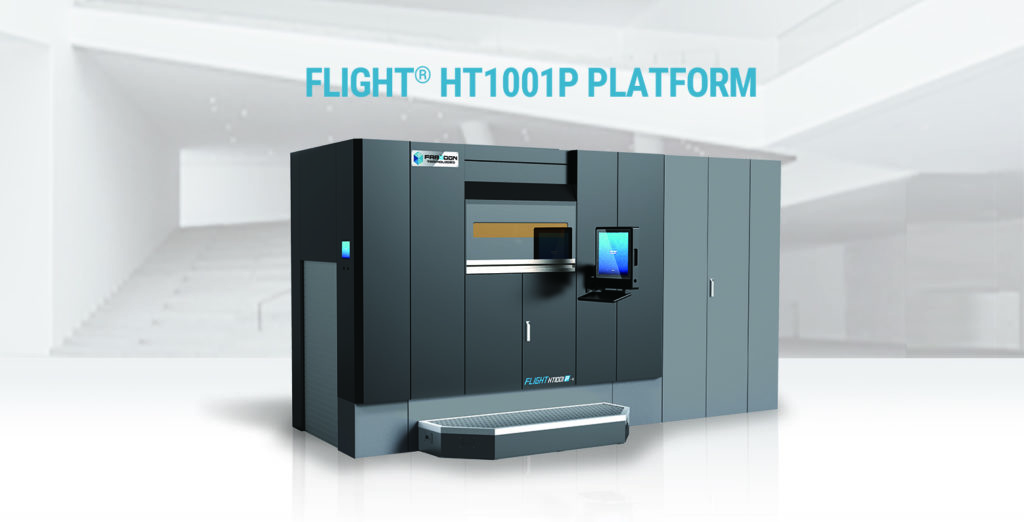One of the primary selling points of Nexa3D’s selective laser sintering (SLS) systems was they were the sole machines with four lasers to increase productivity. Now, however, the California startup has competition from what is quickly becoming a powder bed fusion (PBF) behemoth: Farsoon Technologies. The Chinese PBF manufacturer has announced a large-format, quad-laser SLS printer for polymers.
Farsoon’s Quad-Laser Polymer 3D Printer
With four lasers, the HT1001P Continuous Additive Manufacturing Solution (CAMS) system is a follow-up to Farsoon’s dual-laser Flight HT1001P-2 machine announced at Rapid Tech 3D in May 2022. The Flight HT1001P Platform features a large build volume of 1000 × 500 × 450mm and can now be outfitted with dual or quad 300W fiber lasers with scanning speeds of up to 20 m/s.
As a result, the printer can run at a production rate of 275 percent that of single 500W laser Flight 403P1 machines, with a production yield of 5.6 times that of a single 100W CO2 laser. Additionally, the CAMS concept makes use of an exchangeable build cartridge and conveyor system for improved automation. Together with quad-lasers, the HT1001P system can run two full 225L builds in a single day.
With a build chamber capable of reaching 220℃, the printer can process high-temperature materials, such as PA6 for end-use parts. Multi-zone heating and temperature control are meant to ensure uniform heat distribution throughout the platform, resulting in consistent mechanical properties and surface quality.
Farsoon’s printers, including this latest addition, are designed to be open, allowing users to access all of the necessary parameters to tailor the functioning of the equipment. This includes the ability to tune the machines to work with third-party materials for specific applications.
Farsoon’s Quad-Laser in the 3D Printing Market
As Farsoon kicks off a beta program for the four-laser HT1001P machine, it’s already rapidly advancing its position in the PBF market. On the metal PBF front, the company is competing in what 3DPrint.com refers to as the “laser wars” with an eight-laser 3D printer, which will surely be useful for rocket engine production. Meanwhile, it has filled out its metal PBF portfolio with smaller, but still large, and less productive, but still high-throughput machines with four and six lasers.
For polymers, Farsoon’s strategy has involved cutting ties with its French partner, Prodways, while it expands its own SLS lineup. With more lasers and large build areas, Farsoon machines could rival the new generation of non-laser-based polymer PBF from the likes of Stratasys, HP, and, in the future, Visitech.
Additionally, by joining the ColdMetalFusion Alliance, it has essentially begun porting its polymer technology into another, low-cost metal 3D printing technology. This allows it to potentially take on the burgeoning segment of metal binder jetting without entering that market with its own binder jet machine. As Cold Metal Fusion is rolled out commercially, we’ll have to see how it compares to binder jetting and metal PBF.
Subscribe to Our Email Newsletter
Stay up-to-date on all the latest news from the 3D printing industry and receive information and offers from third party vendors.
Print Services
Upload your 3D Models and get them printed quickly and efficiently.
You May Also Like
3D Printing News Briefs, June 11, 2025: Sustainability, Automotive Tooling, & More
We’re starting with sustainability news in today’s 3D Printing News Briefs, as EOS has strengthened its commitment on climate responsibility, and Zestep is making 3D printing filament out of eyewear...
3D Printing 50 Polymer Stand-In Parts for Tokamaks at the PPPL & Elytt Energy
Of all the world’s things, a tokamak is one of the hardest, most complex, expensive and exacting ones to make. These fusion energy devices make plasma, and use magnets to...
3D Printing News Briefs, May 17, 2025: Color-Changing Materials, Humanoid Robot, & More
We’re covering research innovations in today’s 3D Printing News Briefs! First, Penn Engineering developed 3D printed materials that change color under stress, and UC Berkeley researchers created an open source,...
Firehawk Aerospace Partners with JuggerBot 3D, Gets $1.25M from AFWERX for 3D Printed Propellants
Texas-based Firehawk Aerospace, an advanced energetic materials firm that works with aerospace and defense applications, announced a strategic partnership with JuggerBot 3D, an Ohio-based large-format 3D printer manufacturer. Together, the...


































